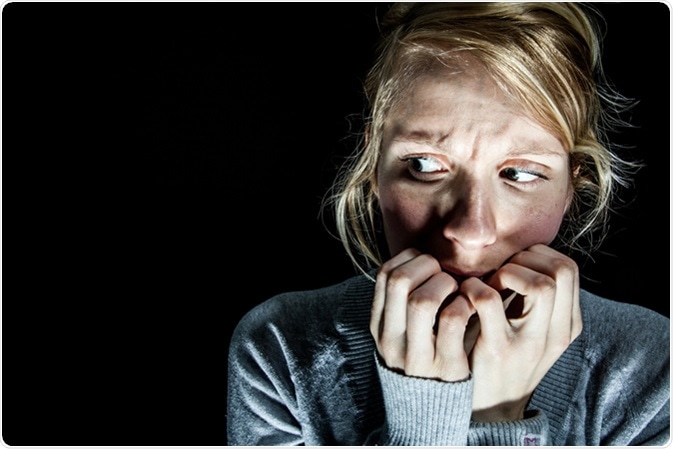Phobias represent significant types of anxiety disorder, defined as an excessive and irrational fears experienced by an individual. A person with a phobia becomes panicky when encountering the source of fear, which can be a place, incident, situation or an object. The phobia is usually linked to something specific, unlike general anxiety disorder.

Image Credit: Benoit Daoust / Shutterstock
It is believed that phobias generally emerge from highly traumatic experiences. The fear that the person experiences gets transferred from one situation to the other, or reoccurs throughout life. For example, the person develops a fear of water when he sees a drowning incident that is unforgettable.
Phobia and anxiety disorder are relatively common. An individual does not experience any symptoms until he comes into contact with the source of phobia. Phobia can be treated with cognitive behavioral therapy using fear reduction techniques. In many cases, antidepressant medication has proven helpful during the early stages.
There are numerous objects or situations due to which someone could develop a phobia. However, all of them can be categorized into two main forms: specific or simple phobias, and complex phobias.
Specific or Simple Phobias
A specific or simple phobia is an unreasonable fear caused by the presence of a particular situation or object. This type of phobia is known to cause mild or no danger, and it often develops during childhood and become less severe as the individual get older.
Common types of simple phobia include:
- Animal phobia also known as zoophobia, this is the irrational fear that happens when a person faces an animal (other phobias associated with animal phobia are cynophobia, apiphobia and orithophobia)
- Environmental phobia: environmental phobias occur when an individual is involved in a specific natural situation or event (this phobia consists of other phobias like acrophobia and astrphobia)
- Situation phobia: Fear such as visiting the dentist, etc.
- Bodily phobia: The fear that arises due to an invasive medical procedure and sometimes by witnessing injury or blood; in some instances people with bodily phobia may lose their consciousness
Complex Phobia
Complex phobias are known to be disruptive or creating a more disabling impact on life when compared to specific phobias. These phobias mostly develop during adulthood and are associated with a deep-rooted fear about a certain situation or circumstance.
Sometimes complex phobias continue for many years. There are several types of complex phobias, and some common examples include agoraphobia and social phobia.
Agoraphobia is associated with the fear of open spaces, but it can be more complex than that. This type of phobia is not simply seen as a fear of a certain situation, unless it eliminates the feeling of the patient as if he is trapped, helpless, in panic, etc. The agoraphobic patient tends to be anxious at the situation or places from where escape is difficult, or help would not be available if panic attack ensues.
A person with agoraphobia may be scared of traveling on public transport, visiting a shopping center, or even being alone at home (in most severe cases of this condition). On the other hand, in social phobia an individual is afraid to face the life or social situations. The patients tends to act abnormally nervous. Moreover, the affected person might feel afraid of talking in front of people or in public in fear of being humiliated. Social phobia is also known as Social Anxiety Disorder (SAD).
A person with social phobia may have a fear of:
- public speaking
- using public restrooms
- eating with other people
- social contact in general
Similarities and Differences Between Simple and Complex Phobias
Most phobias have similar symptoms. Some of the common symptoms are an excessive fear of a specific object or situation, avoidance of objects or situations that causes great distress, as well as the presence of physical changes such as nausea, sweating, shaking, breathing difficulties, dizziness and lightheadedness (characterized as panic attack).
However, there are some differences as well. Simple phobias usually develop in early childhood, i.e., between 4 and 8 years. On the other hand, complex phobias develop in adolescence or are created by traces of the early childhood experiences.
Furthermore, it is believed that simple phobias may or may not be caused genetically (running in families). Usually, such phobias are the result of negative reactions or panic attacks related to a specific object or situation, and are sometimes acquired from other peoples’ experience. For instance, if someone shares the phobia with other family members (like the fear of spider or arachnophobia), this may be because they have learned about the fear of spider as a child.
However, when considering complex phobias, the exact causes of agoraphobia and social phobia are unknown. Some believe that genetic traits, brain chemistry, and life experience may all play a part in the development of these phobias.
Further Reading
Last Updated: Aug 23, 2018